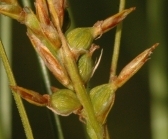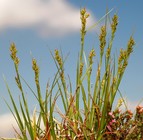Cyperaceae taxon details
Carex bolusii C.B.Clarke
1695691 (urn:lsid:marinespecies.org:taxname:1695691)
accepted
Species
Carex parvirufa Luceño & Márq.-Corro · unaccepted
Schoenoxiphium bracteosum Kukkonen · unaccepted
terrestrial
Clarke, C. B. (1898). Cyperaceae. In: Thiselton-Dyer, W.T. (ed.), Flora capensis: being a systematic description of the plants of the Cape colony, Caffraria, & Port Natal (and neighbouring territories). Vol. VII. Pontederiaceae to Gramineae, pp. 149-310. L. Reeve & Co., Covent Garden; Williams & Norgate, Covent Garden, London., available online at https://www.biodiversitylibrary.org/page/30235904#page/157/mode/1up
page(s): 304 [details]
(of Carex parvirufa Luceño & Márq.-Corro) Márquez-Corro, J. I.; Maguilla, E.; Villaverde, T.; Martín-Bravo, S.; Luceño, M. (2017). Two new species in <i>Carex</i> sect. <i>Schoenoxiphium</i> (Cyperaceae) from southern Africa. <em>Phytotaxa.</em> 303(1): 34-46., available online at https://doi.org/10.11646/phytotaxa.303.1.2 [details] Available for editors [request]
[request]
page(s): 304 [details]
(of Carex parvirufa Luceño & Márq.-Corro) Márquez-Corro, J. I.; Maguilla, E.; Villaverde, T.; Martín-Bravo, S.; Luceño, M. (2017). Two new species in <i>Carex</i> sect. <i>Schoenoxiphium</i> (Cyperaceae) from southern Africa. <em>Phytotaxa.</em> 303(1): 34-46., available online at https://doi.org/10.11646/phytotaxa.303.1.2 [details] Available for editors
Description Rhizome caespitose, with short internodes moderately stout, light-brown to dark-brown. Flowering culms (4)12–67(95) cm...
Taxonomic remark Source in seed data: wcs Update namepublishedIn from Fl. Cap. (Harvey) 7(2): 304. 1898 [Jul 1898] to Fl. Cap. 7: 304...
Description Rhizome caespitose, with short internodes moderately stout, light-brown to dark-brown. Flowering culms (4)12–67(95) cm long, erect, obtusely trigonous, smooth, occasionally with any minute prickle to the apex, leafy from one third to nearly half of its length, (0.3)0.8–1.2(1.5) mm wide at the middle. Leaves (0.5)1.7–3.8(5.5) mm wide, shorter, rarely longer (in dwarf plants) than the inflorescence, slightly to moderately rigid, straight at the apex, light-green to somewhat glaucous, flat to ± V-shaped in cross-section, slightly to moderately scabrous along the edges and usually along the abaxial midrib; adaxial surface usually finely papillose; ligule (0.5)0.8–3(4) mm long. Basal sheaths with lamina or, more rarely, the lowermost bladeless, entire, somewhat broken or slightly fibrous. Lowest bract of the inflorescence leaf-like, from half of the inflorescence length to equaling it, with a sheath (9)17–51(73) mm long. Inflorescence up to the upper ½ of the length of the culm, branching up to 3(4) times; partial inflorescences (5)6–8(9), erect, the uppermost sessile, overlapping, the lowermost usually distant, long-pedunculate. Glumiform perigynia and glumiform cladoprophylls absent. Tubular cladoprophylls always present. Utriculiform cladoprophylls usually present, similar to bisexual utricles. Male glumes 2.2–3(3.3) × (1)1.1–1.8(2) mm, ovate to obovate, yellowish-brown to brown, with a green central band, ending in an aculeate mucro up to 2 mm long. Female glumes 2–2.7(3.1) × (1.1)1.3–2(2.1) mm, ovate, yellowish-brown, with a green central band, ending in an aculeate mucro up to 2.8(3.1) mm long, arising from the back, a little below the apex of the glume. Unisexual utricles (2)2.5–3.6(4) × (0.6)1–1.4(1.6) mm, ovoid to ellipsoid, stipitate, straight or, more rarely, slightly arcuate, straw-coloured to yellowish-brown when mature, dispersely aculeate to hispid in the upper third, with conspicuous prominent veins over the entire surface, suberect to erecto-patent, abruptly contracted into an aculeate, bidentate to irregular beak (0.3)0.5–1 mm long; rachilla reaching the apex to protruding from it up to 0.3(0.4) mm. Bisexual utricles usually present, widely and obliquely truncate at the apex. Achenes (1.2)1.4–2.2(2.5) × (0.7)0.8–1.2(1.5) mm, ellipsoid-trigonous, straw-coloured to yellowish-brown when mature, tipped by a short, obtusely trigonous, usually asymmetric, persistent style base. [details]
Taxonomic remark Source in seed data: wcs Update namepublishedIn from Fl. Cap. (Harvey) 7(2): 304. 1898 [Jul 1898] to Fl. Cap. 7: 304...
Taxonomic remark Source in seed data: wcs Update namepublishedIn from Fl. Cap. (Harvey) 7(2): 304. 1898 [Jul 1898] to Fl. Cap. 7: 304 (1898), information provided by Alan E. on email Jun. 07 2021 More details could be found in [details]
Cyperaceae Working Group. (2025). [see How to cite]. Global Cyperaceae Database. Carex bolusii C.B.Clarke. Accessed at: https://cyperaceae.org/aphia.php?p=taxdetails&id=1695691 on 2025-09-11
Date
action
by
![]() The webpage text is licensed under a Creative Commons
Attribution 4.0 License
The webpage text is licensed under a Creative Commons
Attribution 4.0 License
Nomenclature
original description
Clarke, C. B. (1898). Cyperaceae. In: Thiselton-Dyer, W.T. (ed.), Flora capensis: being a systematic description of the plants of the Cape colony, Caffraria, & Port Natal (and neighbouring territories). Vol. VII. Pontederiaceae to Gramineae, pp. 149-310. L. Reeve & Co., Covent Garden; Williams & Norgate, Covent Garden, London., available online at https://www.biodiversitylibrary.org/page/30235904#page/157/mode/1up
page(s): 304 [details]
original description (of Carex parvirufa Luceño & Márq.-Corro) Márquez-Corro, J. I.; Maguilla, E.; Villaverde, T.; Martín-Bravo, S.; Luceño, M. (2017). Two new species in <i>Carex</i> sect. <i>Schoenoxiphium</i> (Cyperaceae) from southern Africa. <em>Phytotaxa.</em> 303(1): 34-46., available online at https://doi.org/10.11646/phytotaxa.303.1.2 [details] Available for editors [request]
[request]
original description (of Schoenoxiphium bracteosum Kukkonen) Hilliard, O.M.; Burtt, B.L. (1986). Notes on some plants of southern Africa chiefly from Natal: XIII. <em>Notes from the Royal Botanic Garden Edinburgh.</em> 43(3): 345-405., available online at https://archive.org/details/notes-from-royal-botanic-garden-edinburgh-43-003-345-405/mode/2up
page(s): 365; note: New species published by Kukkonen in Hilliard & Burtt, 1986. [details]
basis of record Plants of the World Online (POWO). , available online at https://powo.science.kew.org/ [details]
page(s): 304 [details]
original description (of Carex parvirufa Luceño & Márq.-Corro) Márquez-Corro, J. I.; Maguilla, E.; Villaverde, T.; Martín-Bravo, S.; Luceño, M. (2017). Two new species in <i>Carex</i> sect. <i>Schoenoxiphium</i> (Cyperaceae) from southern Africa. <em>Phytotaxa.</em> 303(1): 34-46., available online at https://doi.org/10.11646/phytotaxa.303.1.2 [details] Available for editors
original description (of Schoenoxiphium bracteosum Kukkonen) Hilliard, O.M.; Burtt, B.L. (1986). Notes on some plants of southern Africa chiefly from Natal: XIII. <em>Notes from the Royal Botanic Garden Edinburgh.</em> 43(3): 345-405., available online at https://archive.org/details/notes-from-royal-botanic-garden-edinburgh-43-003-345-405/mode/2up
page(s): 365; note: New species published by Kukkonen in Hilliard & Burtt, 1986. [details]
basis of record Plants of the World Online (POWO). , available online at https://powo.science.kew.org/ [details]
 Present
Present  Inaccurate
Inaccurate  Introduced: alien
Introduced: alien  Containing type locality
Containing type locality
From editor or global species database
Description Rhizome caespitose, with short internodes moderately stout, light-brown to dark-brown. Flowering culms (4)12–67(95) cm long, erect, obtusely trigonous, smooth, occasionally with any minute prickle to the apex, leafy from one third to nearly half of its length, (0.3)0.8–1.2(1.5) mm wide at the middle. Leaves (0.5)1.7–3.8(5.5) mm wide, shorter, rarely longer (in dwarf plants) than the inflorescence, slightly to moderately rigid, straight at the apex, light-green to somewhat glaucous, flat to ± V-shaped in cross-section, slightly to moderately scabrous along the edges and usually along the abaxial midrib; adaxial surface usually finely papillose; ligule (0.5)0.8–3(4) mm long. Basal sheaths with lamina or, more rarely, the lowermost bladeless, entire, somewhat broken or slightly fibrous. Lowest bract of the inflorescence leaf-like, from half of the inflorescence length to equaling it, with a sheath (9)17–51(73) mm long. Inflorescence up to the upper ½ of the length of the culm, branching up to 3(4) times; partial inflorescences (5)6–8(9), erect, the uppermost sessile, overlapping, the lowermost usually distant, long-pedunculate. Glumiform perigynia and glumiform cladoprophylls absent. Tubular cladoprophylls always present. Utriculiform cladoprophylls usually present, similar to bisexual utricles. Male glumes 2.2–3(3.3) × (1)1.1–1.8(2) mm, ovate to obovate, yellowish-brown to brown, with a green central band, ending in an aculeate mucro up to 2 mm long. Female glumes 2–2.7(3.1) × (1.1)1.3–2(2.1) mm, ovate, yellowish-brown, with a green central band, ending in an aculeate mucro up to 2.8(3.1) mm long, arising from the back, a little below the apex of the glume. Unisexual utricles (2)2.5–3.6(4) × (0.6)1–1.4(1.6) mm, ovoid to ellipsoid, stipitate, straight or, more rarely, slightly arcuate, straw-coloured to yellowish-brown when mature, dispersely aculeate to hispid in the upper third, with conspicuous prominent veins over the entire surface, suberect to erecto-patent, abruptly contracted into an aculeate, bidentate to irregular beak (0.3)0.5–1 mm long; rachilla reaching the apex to protruding from it up to 0.3(0.4) mm. Bisexual utricles usually present, widely and obliquely truncate at the apex. Achenes (1.2)1.4–2.2(2.5) × (0.7)0.8–1.2(1.5) mm, ellipsoid-trigonous, straw-coloured to yellowish-brown when mature, tipped by a short, obtusely trigonous, usually asymmetric, persistent style base. [details]Taxonomic remark Source in seed data: wcs Update namepublishedIn from Fl. Cap. (Harvey) 7(2): 304. 1898 [Jul 1898] to Fl. Cap. 7: 304 (1898), information provided by Alan E. on email Jun. 07 2021 More details could be found in [details]
To European Nucleotide Archive, ENA (Carex parvirufa) (from synonym Carex parvirufa Luceño & Márq.-Corro)
To Genbank (from synonym Carex parvirufa Luceño & Márq.-Corro)
To GenBank (33 nucleotides; 4 proteins) (from synonym Schoenoxiphium bracteosum Kukkonen)
To International Plant Names Index (IPNI) (from synonym Schoenoxiphium bracteosum Kukkonen)
To International Plant Names Index (IPNI) (from synonym Carex parvirufa Luceño & Márq.-Corro)
To International Plant Names Index (IPNI)
To IUCN Red List (Least Concern) (from synonym Carex parvirufa Luceño & Márq.-Corro)
To Plants of the World Online (from synonym Schoenoxiphium bracteosum Kukkonen)
To Plants of the World Online (from synonym Carex parvirufa Luceño & Márq.-Corro)
To Plants of the World Online
To Royal Botanic Garden Edinburgh Herbarium (Schoenoxiphium bracteosum E00200231 type 1) (from synonym Schoenoxiphium bracteosum Kukkonen)
To Genbank (from synonym Carex parvirufa Luceño & Márq.-Corro)
To GenBank (33 nucleotides; 4 proteins) (from synonym Schoenoxiphium bracteosum Kukkonen)
To International Plant Names Index (IPNI) (from synonym Schoenoxiphium bracteosum Kukkonen)
To International Plant Names Index (IPNI) (from synonym Carex parvirufa Luceño & Márq.-Corro)
To International Plant Names Index (IPNI)
To IUCN Red List (Least Concern) (from synonym Carex parvirufa Luceño & Márq.-Corro)
To Plants of the World Online (from synonym Schoenoxiphium bracteosum Kukkonen)
To Plants of the World Online (from synonym Carex parvirufa Luceño & Márq.-Corro)
To Plants of the World Online
To Royal Botanic Garden Edinburgh Herbarium (Schoenoxiphium bracteosum E00200231 type 1) (from synonym Schoenoxiphium bracteosum Kukkonen)










